

The anatomic dead space fills with inspired air at the end of each inspiration, but this air is exhaled unchanged. Read More: What is an immediate in MIPS? What is the anatomical dead space and what is its physiological importance?Īnatomic dead space is the total volume of the conducting airways from the nose or mouth down to the level of the terminal bronchioles, and is about 150 ml on the average in humans. : the dead space in that portion of the respiratory system which is external to the alveoli and includes the air-conveying ducts from the nostrils to the terminal bronchioles - compare physiological dead space. What is the best definition of anatomical dead space? What is the anatomical dead space?Īnatomic dead space specifically refers to the volume of air located in the respiratory tract segments that are responsible for conducting air to the alveoli and respiratory bronchioles but do not take part in the process of gas exchange itself. Figure 3.1a shows a male body in anatomical position. What is the difference between anatomical and physiological?Īnatomy refers to the internal and external structures of the body and their physical relationships, whereas physiology refers to the study of the functions of those structures. In these spaces, the lungs are ventilated and receiving enough air, but blood is not being oxygenated in that space because the air is not reaching perfused areas.

Why is anatomical dead space?Īnatomical dead space occurs naturally in areas of the lungs that don’t come in contact with alveoli (like the trachea). The physiological dead space is the combination of anatomic and alveolar dead space. Thus, only one alveolus is receiving ventilation and perfusion (alveolus 2) alveolus 1 and 3 are being ventilated but not perfused (ie, alveolar dead space).

Is alveolar dead space the same as physiological dead space? The anatomical dead space is the total volume of the conducting airways from the nose or mouth to the terminal bronchioles, and in ventilated infants includes the apparatus dead space (endotracheal tube and flow sensor). The physiological dead space is the anatomical dead space plus alveolar dead space. … In healthy lungs where the alveolar dead space is small, Fowler’s method accurately measures the anatomic dead space by a nitrogen washout technique. Anatomical dead space is that portion of the airways (such as the mouth and trachea to the bronchioles) which conducts gas to the alveoli.


 0 kommentar(er)
0 kommentar(er)
